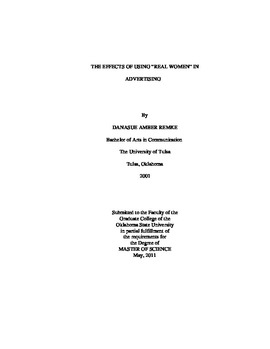| dc.contributor.advisor | Fullerton, Jami A. | |
| dc.contributor.author | Remke, Danasue Amber | |
| dc.date.accessioned | 2014-04-16T03:10:15Z | |
| dc.date.available | 2014-04-16T03:10:15Z | |
| dc.date.issued | 2011-05-01 | |
| dc.identifier.uri | https://hdl.handle.net/11244/9719 | |
| dc.description.abstract | Dove launched its widely publicized "Campaign for Real Beauty" in 2004 based on the premise that women around the globe felt that beauty portrayed in mainstream media contained unrealistic images that most women could not attain. The advertisements created for the campaign featured women that embodied characteristics closer to those of the average female. But are advertisements that use more realistic models as effective as those that use "ideal" models? This study seeks to answer that question using an experimental design to determine whether there is a difference in females' attitude toward an ad featuring an "ideal" model or a more realistic model, and whether body-esteem or self-esteem moderate this effect. The methodology for this study is a post-test only experimental design with a control group. Participants were randomly assigned one of three different print advertisements for a beauty product. One ad features a "real" model, one features an "ideal" model, and the third ad contains a close-up image of the product in place of the model. A total of 293 female respondents enrolled in both undergraduate and graduate programs at Oklahoma State University participated in the study. Results of the study show that regardless of high or low body- or self-esteem, the women surveyed preferred the ad featuring the more realistic model. This study has important implications for providing a greater understanding of how media affects self-image, as well as the implications of these unrealistic standards and how they impact a consumer's attitudes toward advertising. This study also has important implications for American women with an unrealistic image of true beauty. If advertisements focused on portraying more realistic models, American females' perception of beauty could possibly shift away from an unattainable ideal to a more realistic vision of beauty. | |
| dc.format | application/pdf | |
| dc.language | en_US | |
| dc.publisher | Oklahoma State University | |
| dc.rights | Copyright is held by the author who has granted the Oklahoma State University Library the non-exclusive right to share this material in its institutional repository. Contact Digital Library Services at lib-dls@okstate.edu or 405-744-9161 for the permission policy on the use, reproduction or distribution of this material. | |
| dc.title | Effects of Using Real Women in Advertising | |
| dc.type | text | |
| dc.contributor.committeeMember | McKinnon, Lori | |
| dc.contributor.committeeMember | Lewis, Bobbikay | |
| osu.filename | Remke_okstate_0664M_11465.pdf | |
| osu.college | Arts and Sciences | |
| osu.accesstype | Open Access | |
| dc.description.department | School of Media and Strategic Communications | |
| dc.type.genre | Thesis | |
| dc.subject.keywords | advertising | |
| dc.subject.keywords | beauty | |
| dc.subject.keywords | dove | |
